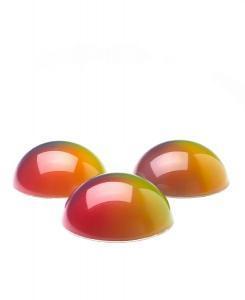Judy Chicago: Moving Women Forward
After having faced
centuries of discrimination, women in the early twentieth century started a
feminist movement. Feminism included, but was not limited to: protests against
female exclusion from exhibitions, institutions, and employment; spreading
awareness of female discrimination (e.g. female art works represented only 1%
of the works on display at the Los Angeles County Museum of Art, Chadwick 355);
and creating female social welfare programs. In a time when women were
continuously objectified and undervalued, and men were highly over-praised,
many women believed that women’s personal experiences needed to be reinserted
into art; they sought to valorize women’s
personal experience (Chadwick 356). Even if their male counterparts did not
support them, the feminist movement was powerful enough to distribute and
spread news about female art through publications.
 |
| Name Change Ad, Artforum, Oct., 1970 |
Judy Chicago was one artist at the forefront of the feminist
movement. Chicago was born with the name Judy Cohen, and after marriage her
name changed to Judy Gerowitz. After her husband’s death, when she was 23,
Chicago felt nameless (recall the feelings of Nameless and Friendless by Rebecca Solomon; these sentiments were
still real and present at the time). In 1971, about nine years later, Chicago
officially changes her name to Judy Chicago, signifying her participation in
the feminist movement, and a radical change in her artwork (Chicago). Chicago
taught the first feminist art course at the California State University, Fresno
in 1970. Held in the belief that she should try to valorize women’s experiences
by inserting them into her artwork, Chicago encouraged her female students to
do the same; she taught her female students to be proud of their uniqueness (Chadwick
357).
 |
| Judy Chicago, Domes, 1968 |
 |
| Judy Chicago, Pasadena Lifesavers, 1970 |
To that end, Chicago’s artwork revolved around the female
anatomy: breasts, belly, and most notably, the vagina. For example, Domes and Pasadena Lifesavers, created from
plexiglass, were abstracts that explored female sexuality (notice how the domes
are alike to breasts; the Pasadena Lifesavers have central openings, suggesting the vulva, Chadwick 357). Chicago also practiced a particular style, the “central core” form, which would represent
the female genitalia. This form consisted of images with open, central shapes,
and layered, often petal-like images (Chadwick 358). Female Rejection Drawing is a perfect example of her form. The central core is also used in The Dinner Party, a tribute to women
artists of the past. Chicago believed that, by including her imagery, she was
reclaiming and celebrating women’s “otherness”; she believed that her artwork
did away with the female notion of inferiority, and replaced it with pride
(Elizabeth A. Sackler Center for Feminist Art: The Dinner Party).
 |
Judy Chicago, Female Rejection Drawing, from Rejection Quintet, 1974
|
Although Chicago placed a huge emphasis on the biological
aspect of a woman to show her uniqueness, she did not want the female
experience to be solely based on biology. In other words, she did not want
people to believe that a female’s experience is solely determined by her
physical state – far from it, she believed that her social and cultural status
shaped her experiences. She believed that the “womb art” was to be a framework,
or a basis, in order to identify and reverse devaluations of female anatomy in
patriarchical culture (Chadwick 358-359). For example, Whitney Chadwick, in her
book Women, Art, and Society, points out that the “male gaze” is under harsh
critique during the 1970's, more than ever before (Chadwick 377); the male gaze allowed for propagating female inferiority and female objectification. Now, women can show
themselves, as themselves, by their own rules – as retaliation against what the
men have done to devalue women.
Chicago was a key figure in the feminist movement; she
protested against female exclusion through her artwork, and advocated for
female welfare. Her artwork, particularly The
Dinner Party, is a huge attack against male superiority; it is not enough for
women to reclaim history, and reinsert key women figures who have been
overlooked due to patriarchy – they need to be shown with pride and dignity,
for their accomplishments have been great.
Works Cited
Chadwick, Whitney. Women, Art, and Society. Fourth Edition. London: Thames and Hudson Ltd., 2007. Print.
Chicago, Judy, and
Donald Woodman. JudyChicago. Judy Chicago, 2012. Web. 20 Nov. 2012.
http://www.judychicago.com.
"Elizabeth A. Sackler Center for
Feminist Art: The Dinner Party." BrooklynMuseum.org. Brooklyn Museum,
2011. Web. 20 Nov. 2012.
<http://www.brooklynmuseum.org/eascfa/dinner_party/core_imagery.php>.
I like how you linked the Nameless and Friendless painting from the 19th century to the 20th century artist but I think you mixed up the artists' name, I think Nameless and Friendless was by Emily Mary Osborn.
ReplyDelete